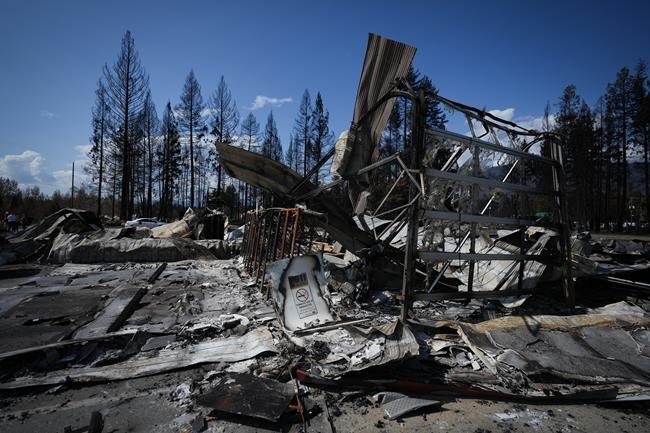British Columbia's forest watchdog has confirmed it is investigating the province's response to wildfires that ripped through small communities on the shores of Shuswap Lake in August, destroying or damaging more than 200 properties.
A statement from the Forest Practices Boardon Friday says it launched the probe after receiving a complaint about the BC Wildfire Service's use of a planned ignition aimed at reducing forest fuels in the path of a blaze near populated areas.
At the time the back burn was lit on Aug. 17,two blazes, the Lower East Adams Lake and Bush Creek wildfires, had been steadily moving toward the northern shore of Shuswap Lake after igniting about five weeks earlier.
The board says it has notified the wildfire service and it's arranging for investigators to visit the area this month near Lee Creek and neighbouring Scotch Creek, in B.C.'s southern Interior.
Lee Creek resident Jim Cooperman says he filed the complaint with the board, alleging "gross negligence" by the BC Wildfire Service in conducting the planned ignition just beyond power lines about two kilometres from his home.
Cooperman says he's convinced it was the planned ignition, not the wildfires themselves, that raced down the slope onAug. 18, whipped up by high winds.
The flames would eventually stop about 15 metres from the back of his home on the property where Cooperman says he's lived since 1969.
"We have 40 acres and 36 of them are burnt toast," he says.
"Our home place is now just ashes and burnt sticks. It's very difficult for us."
Cooperman says one of his neighbours who works for the BC Wildfire Service was at home, listening to his work radio, while the back burn was happening.
He says that neighbour recently told him what he heard on the radio.
"At 5 o'clock we saw a giant cloud of smoke right above our house. And then at 7 o'clock, on the radio, they were saying to all their people that the fire had escaped and broken through the fire guard, which was the power line," Cooperman says, describing the area cleared to make way for the power lines.
"They knew at 7 o'clock that it was failing, and yet they told the public that it was a success," he told The Canadian Press in an interview on Friday.
A statement from the Forests Ministry says the BC Wildfire Service "welcomes the Forest Practices Board review as an independent and recognized third-party."
It says the planned ignition along a 10-kilometre stretch of power lines began at approximately 3 p.m. on Aug. 17 and it was complete by about 5 p.m.
The south flank of the advancing Lower East Adams Lake wildfire was already burning within 1.5 kilometres of the power lines, the ministry says.
"The purpose of (the burn) was not to contain the wildfire but reduce its intensity and provide a greater chance of survival to any structures in its projected path," it says. "While we know the extreme conditions on the day resulted in significant structure loss, we know the planned ignition saved structures in Lee Creek."
Cooperman says the power lines meant to act as a fire break were surrounded by dead brush and instead became a "conduit" for the flames.
"When they lit that thing and the wind switched, it just raced down that power line right to Scotch Creek and Celista and everywhere."
A bulletin posted by the Columbia Shuswap Regional District at 8:30 p.m. on the day of the planned ignition says the operation was successful.
The aerial ignition of about 26 square kilometres was completed "along the power line in the North Shuswap … creating a significant guard line," it says.
"Fire in the ignition area will now safely burn to guards while being monitored by crews patrolling along the power lines," the bulletin says.
"This reduces the risk of embers being cast from out-of-control burning that may occur when winds shift to come from the north later this evening."
Around 12:15 p.m. the following day, Cooperman says his daughter called to say she could see flames in the hills above Scotch Creek.
He says he had packed up and left by 1:15 p.m., about an hour before the regional district issued an evacuation order for the Lee Creek and Scotch Creek areas.
"But other people got trapped," Cooperman says, recounting a story he heard of an elderly couple who tried to escape by boat but it capsized in choppy waters.
The flames Cooperman describes as a "firestorm" went on to destroy more than 170 properties and damage several dozen more throughout the Shuswap area.
The Skwlax te Secwepemculecw First Nation lost more than 80 structures.
Cooperman says he believes one of the original wildfires swept through that community, not the back burn to the east.
A few days after the firestorm, the director of operations for the BC Wildfire Service defended the planned ignition, saying sustained high winds that changed the course of the fire were responsible for much of the damage.
"We did our planned ignition under the conditions we planned for and it was largely successful," Cliff Chapman told media.
"I want to be perfectly clear: that planned ignition saved hundreds of homes and properties along the north Shuswap."
The Lower East Adams Lake and Bush Creek fires would soon merge and grow to span more than 450 square kilometres before the regional district said the blaze was classified as "being held" in late September. It's now considered under control.
The Forest Practices Board says its probe is expected to take six months to a year.
A panel will consider the findings and possibly make recommendations, it says.
Last month, Premier David Eby announced an expert task force to provide recommendations on enhancing emergency preparedness and response.
This report by The Canadian Press was first published Oct. 13, 2023.
Brenna Owen, The Canadian Press



